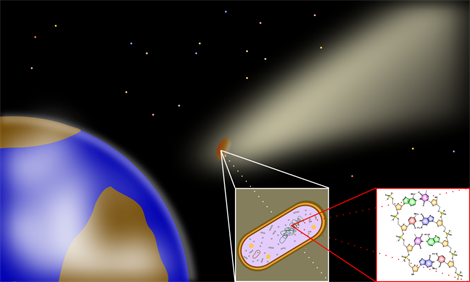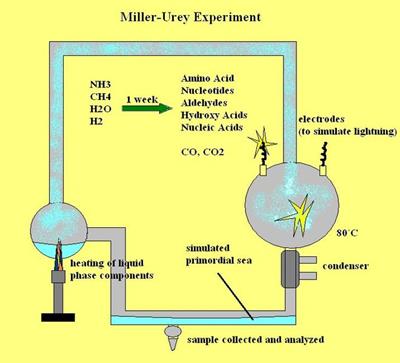PDF chapter test TRY NOW
Extraterresterial or Cosmic origin:
This theory was proposed by Richter and strongly supported by Arrhenius.
According to this theory, life came from outer space in the form of spores which grew and evolved into different organisms. Hence, this theory was also known as the ''theoryof panspermia or spore''.

Image illustrating the theory of Panspermia
Initially, this theory received tremendous support because fossils of microorganisms were found in meteorites in \(1961\). But there was no evidence about the transfer of spores from other planets or how these spores survived while travelling in space.
There are no life forms on any planet except Earth, and there are no specifics concerning spores, their origin, or how they transit interplanetary space to reach Earth. Furthermore, this idea does not add much to the essential details of life's beginning. There was no scientific evidence to back up the theory. As a result, the theory received very little attention and wasn't accepted.
Chemical evolution of life:
This theory was proposed by Oparin (\(1922\)) and Haldane (\(1929\)).
According to this theory, life originated on earth through physio-chemical processes in which atoms combined to form molecules; molecules, in turn, reacted which each other to form inorganic molecules, which gave rise to diverse organic compounds. These organic compounds interacted to form a colloid system that produced life.
Hence, from this theory, they concluded that life originated on earth spontaneously from non-spontaneous living matter in accordance with the everchanging environmental conditions. This was thus known as the chemical evolution.
Due to the lack of experimental evidence, the hypothesis proposed by Haldane did not find much support. To conclusively support this theory, Miller and Urey experimented with a primitive earth setting. In this experiment, gases such as methane, ammonia, hydrogen and water vapour, and electrical discharges were circulated in the setup for a week.
After a week, they found that many organic compounds, including amino acids such as alanine, glycine and aspartic acid, were found. The organic substances found were urea, lactic acid, hydrogen cyanide and acetic acid.

Miller-Urey experimental setup
In another setup, the same gases were circulated without the electric discharge. In this set up there were no organic molecules formed.
As a result of this experiment, they determined that the predominantly reducing environment (produced by an electric discharge that donated electrons) that existed at the time was the basis of spontaneous, organic compound synthesis on early Earth.
As a result of this experiment, they determined that the predominantly reducing environment (produced by an electric discharge that donated electrons) that existed at the time was the basis of spontaneous, organic compound synthesis on early Earth.
A video explaining the Miller-Urey experiment
Reference:
https://en.wikipedia.org/wiki/Panspermia#/media/File:Panspermie.svg
https://commons.wikimedia.org/wiki/File:Miller-Urey.jpg
